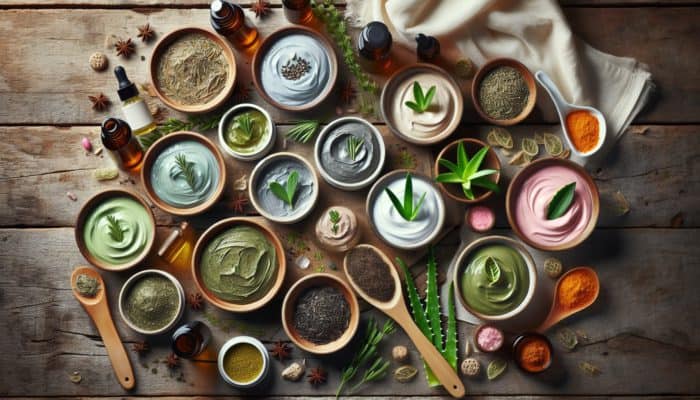Explore the World of DIY Herbal Face Masks in the UK
What Are the Most Popular Herbs Used for Skincare?

DIY Herbal Face Masks: Crafting your herbal face masks is not only a delightful activity but also an enriching experience, especially with the plethora of natural resources found throughout the UK. Utilising herbs in your skincare routine enhances the effectiveness of your masks while fostering a deep sense of connection to the local environment and traditions. Some of the most highly regarded herbs for DIY herbal face masks in the UK include:
- Lavender: Renowned for its soothing properties, lavender is exceptional at calming irritated skin, making it a favourite among skincare enthusiasts.
- Chamomile: Valued for its anti-inflammatory benefits, chamomile is a wonderful choice for individuals with sensitive skin.
- Rosehip: Rich in antioxidants, rosehip oil is renowned for its ability to rejuvenate and deeply hydrate the skin.
- Nettle: Rich in vitamins A, C, and K, nettle can significantly improve skin tone and texture.
- Calendula: Renowned for its healing properties, calendula is particularly beneficial for skin conditions like eczema.
- Yarrow: This herb possesses antiseptic qualities that can help manage acne-prone skin effectively.
- Hibiscus: Often dubbed nature’s Botox, hibiscus is rich in alpha hydroxy acids, which promote a youthful appearance.
- Peppermint: With its refreshing and cooling effects, peppermint can invigorate dull skin while also helping to minimise the appearance of pores.
Each of these herbs offers unique benefits, making them essential in the realm of herbal skincare. By harnessing the power of local flora, you can easily create face masks that not only address your skin’s specific requirements but also celebrate the rich botanical heritage of the UK.
Discover the Advantages of Using Local Ingredients
Utilising local ingredients for your DIY herbal face masks can significantly elevate your skincare regimen. The advantages are plentiful, as herbs cultivated within the UK tend to be fresher, more potent, and better adapted to the local climate. For example, employing herbs such as lavender and chamomile not only ensures the application of high-quality ingredients but also bolsters local farmers and diminishes your carbon footprint.
Local herbs are typically rich in vitamins and minerals that can effectively rejuvenate and nourish the skin. For instance, rosehip oil, harvested from the wild rose bushes native to various regions of the UK, is renowned for its ability to diminish scarring and improve skin texture. Similarly, nettle offers anti-ageing benefits while being readily accessible in the wild during the spring and summer months.
By opting for local herbs, you also reduce exposure to pesticides and chemicals often found in imported ingredients, rendering your DIY face masks not only more organic but also safer for your skin. Furthermore, incorporating seasonal herbs allows you to take full advantage of the freshest produce available at local markets, enhancing both the quality and effectiveness of your skincare products.
How to Efficiently Source UK Herbs for Your Masks
Sourcing high-quality herbs for your DIY face masks is a straightforward endeavour in the UK, given the abundance of local suppliers and markets. To assist you in this process, here are some recommended sourcing locations to consider:
- Local Farmers’ Markets: These venues are fantastic for discovering fresh, organic herbs and forging connections with local growers.
- Herb Shops: Specialist herb shops typically stock a diverse array of dried and fresh herbs that are well-suited for skincare applications.
- Online Suppliers: Websites like The Organic Herb Company provide a wide selection of herbs that can be delivered directly to your doorstep.
- Community Gardens: Engaging with local gardening groups can grant you access to homegrown herbs that are often organically cultivated.
- Wild Foraging: With the right guidance, foraging for herbs like nettle or dandelion can be both an enjoyable and rewarding experience.
- Health Food Stores: These establishments frequently carry dried herbs that are ideal for crafting face masks.
- Craft Fairs: Many artisanal vendors offer bespoke herbal products, including skincare ingredients and other natural remedies.
- Local Herbalists: Consulting with herbalists in your vicinity can provide tailored guidance on effectively sourcing and utilising herbs.
Efficiently sourcing your herbs not only guarantees quality but also promotes sustainability and supports local economies. By exploring these options, you can enrich your DIY herbal face mask experience while fostering a deeper connection with the botanical diversity of your region.
How to Prepare and Store Your Herbal Face Masks for Maximum Freshness

The preparation and storage of your DIY herbal face masks are vital for preserving their efficacy and ensuring they remain fresh. To prepare your herbal face masks effectively, start by selecting your preferred herbs and any additional ingredients you may want to use. Proper preparation often involves drying or steeping the herbs to extract their beneficial compounds fully.
Once your masks are prepared, correct storage is essential. Generally, masks containing fresh ingredients should be used within three days, while those crafted with dried herbs can last up to two weeks when stored in airtight containers. Here are some crucial tips regarding storage conditions:
- Use Airtight Containers: Glass jars or plastic containers with secure seals are ideal for preventing contamination and preserving freshness.
- Store in a Cool, Dark Place: Keeping your masks away from sunlight and heat is essential to maintain the potency of the herbs.
- Label Your Masks: Clearly label all containers with the preparation date to effectively monitor freshness.
- Avoid Moisture: Ensure that all tools and containers are completely dry before storing your masks to prevent mould growth.
- Refrigeration: For masks containing fresh ingredients, refrigeration can significantly extend their shelf life.
By adhering to these best practices, you can ensure that your DIY herbal face masks remain effective and safe for use, allowing you to enjoy the benefits of your homemade skincare products fully.
Insights from Skincare Experts on DIY Herbal Face Masks
What Do Leading UK Skincare Experts Recommend?
Prominent skincare experts in the UK consistently emphasise the importance of high-quality ingredients and customised formulations when creating DIY herbal face masks. They advocate for incorporating herbs that align with your skin type, while also providing targeted benefits. For example, skincare specialist Dr. Emma Smith, celebrated for her expertise in natural skincare, recommends using lavender for its calming effects, particularly for those with sensitive skin types.
A highly effective DIY mask that she frequently endorses is a lavender and oatmeal blend. Oatmeal serves as an excellent exfoliant, while lavender soothes the skin, resulting in a mask that is particularly beneficial for individuals suffering from irritation or redness. Other experts also advocate for the inclusion of green tea due to its robust antioxidant properties, which can help combat signs of ageing and promote a more radiant complexion.
In her practice, Dr. Smith encourages clients to explore various combinations and to be attentive to their skin’s reactions. She often cites a case where a client struggling with dryness experienced significant improvement by incorporating honey and rosehip oil into her masks, which effectively nourished her skin. This personalised approach not only aligns with the principles of natural skincare but also empowers individuals to take charge of their skincare routines.
How Can You Tailor Masks to Your Unique Skin Type?

Customising your herbal face masks to accommodate different skin types is a crucial aspect of DIY skincare. Each skin type possesses distinct needs, and understanding these can lead to the creation of more effective masks. For instance, if you have oily or acne-prone skin, incorporating ingredients like tea tree oil or yarrow can be advantageous due to their antibacterial properties.
For individuals with dry skin, consider using herbs such as aloe vera and rosehip oil, which are renowned for their hydrating qualities. Here is a practical guide to tailoring your masks:
- Identify Your Skin Type: Determine whether your skin is dry, oily, combination, or sensitive.
- Choose Ingredients Accordingly: Select herbs based on your skin type — for oily skin, consider mint or witch hazel; for dry skin, opt for chamomile or honey.
- Test and Adjust: Begin with small batches and adjust the ratios of your ingredients based on your skin’s response.
- Incorporate Carrier Oils: For dry skin, add carrier oils such as jojoba or sweet almond oil to boost moisture levels.
By customising your masks, you can effectively address specific concerns, ensuring your DIY skincare routine is not only enjoyable but also impactful. Understanding your skin type and selecting corresponding ingredients empowers you to create personalised solutions that promote healthier skin.
What Are the Latest Trends in DIY Herbal Face Masks in the UK?
The UK DIY herbal face mask landscape is continually evolving, with new trends emerging that reflect a growing interest in natural and sustainable skincare practices. One notable trend is the growing popularity of superfoods in skincare, with ingredients such as spirulina and matcha gaining traction. These ingredients are praised for their high antioxidant levels and rejuvenating properties for the skin.
In addition to these superfoods, there is a noticeable shift towards *seasonal ingredients*, where skincare enthusiasts are encouraged to utilise what is available in their gardens or local markets. This approach not only adds freshness but also aligns with the sustainability and environmental consciousness that many consumers now prioritise. Experts like skin therapist Sarah Jones recommend keeping an eye on seasonal herbs, such as *elderflower* in spring, known for its brightening effects.
Furthermore, the trend of minimalism in skincare is also influencing DIY practices. Busy individuals are gravitating towards straightforward, multi-functional masks that can address multiple skin concerns simultaneously without the need for extensive routines. Masks incorporating honey and oatmeal, for instance, can cleanse, exfoliate, and hydrate all in one application. Skincare experts suggest that this trend is not merely about simplicity but also about enhancing the skincare experience with fewer, higher-quality ingredients.
How Can You Ensure Safety and Hygiene in Your DIY Skincare Routine?
Maintaining safety and hygiene during the preparation and application of DIY herbal face masks is crucial to avoiding adverse skin reactions. Skincare professionals in the UK recommend adopting several best practices to ensure your skincare routine remains safe and enjoyable.
Firstly, always ensure that your hands and any tools you utilise are clean. Begin by washing your hands with warm, soapy water before preparing your mask, and choose clean utensils and containers. This simple step significantly reduces the risk of contamination. Secondly, remember to perform a patch test before applying any new mask to your face. Apply a small amount of the mask to an inconspicuous area, such as your wrist or behind your ear, and wait 24 hours to monitor for any allergic reactions.
Regarding storage, adhere to the guidelines mentioned earlier to keep your masks fresh and effective. It’s essential to avoid using any masks that have altered in colour or developed an unusual smell, as these are indicators of spoilage. Additionally, experts recommend maintaining notes on the ingredients and preparation dates to help track the freshness of your masks.
Lastly, consider the quality of your ingredients. Opt for organic or locally sourced herbs whenever possible, as these are less likely to contain pesticides or harmful additives. By following these guidelines, you can ensure that your DIY herbal face masks are safe, hygienic, and effective in maintaining your skin’s health.
What Are the Benefits of Incorporating Seasonal Ingredients into Your Masks?
Incorporating seasonal ingredients into your DIY herbal face masks is highly beneficial, not only for your skin but also for your overall wellness. UK skincare experts recommend this practice, as it ensures you are using the freshest and most potent ingredients available. Seasonal herbs often possess heightened nutritional profiles, as they are harvested at their peak, providing maximum benefits.
For example, using spring herbs such as nettles and chickweed can offer refreshing and revitalising effects on the skin after a long winter. These herbs are rich in vitamins and minerals that can help rejuvenate dull skin. In the summer, lavender and calendula can provide soothing properties for sun-exposed skin, helping to alleviate irritation and redness.
Moreover, utilising seasonal ingredients fosters a connection with nature and a sustainable approach to skincare. It reduces the environmental impact associated with transporting out-of-season produce. This practice also supports local farmers and economies, creating a holistic approach to beauty. By aligning your skincare routine with seasonal rhythms, you can enhance your skin’s health while nurturing a deeper appreciation for the changing landscape around you.
How to Create Your Own Basic Herbal Face Mask
What Ingredients Are Needed for a Simple Mask?
Crafting a basic herbal face mask is both straightforward and rewarding, particularly when you have the right ingredients on hand. Here is a list of essential components you might consider incorporating into a foundational herbal face mask:
- Base Ingredients: Natural ingredients such as honey, yoghurt, or oatmeal serve as excellent bases for your mask.
- Herbs: Select one or two herbs based on your skin type, such as chamomile for sensitive skin or nettle for oily skin.
- Liquid Additives: Use herbal teas or aloe vera gel to mix with your base for added benefits.
- Essential Oils: Consider adding a few drops of essential oils, such as tea tree oil for acne-prone skin or lavender for a calming effect.
- Binding Agents: If your mask requires thickening, you can include ingredients such as cornstarch or kaolin clay.
- Exfoliants: Incorporate natural exfoliants such as ground oats or sugar for a mask that also removes dead skin cells.
- Moisturisers: Add oils such as jojoba or almond oil to ensure hydration.
These ingredients can be conveniently sourced from local markets or health food stores, ensuring your mask is both effective and environmentally friendly. The combination of these ingredients offers flexibility in crafting a mask tailored to your unique skincare needs.
Step-by-Step Guide to Creating Your Mask
Creating your herbal face mask is a straightforward process that can be personalised to your preferences. Here’s a step-by-step guide to help you get started.
1. Select Your Ingredients: Choose your base ingredient, herb, and any additional components you wish to incorporate. For instance, you might select yoghurt as your base and chamomile as your herb.
2. Prepare the Herbs: If using fresh herbs, finely chop them or steep dried herbs in hot water to extract their beneficial properties. Allow the infusion to cool before usage.
3. Combine the Base: In a bowl, mix your base ingredient with the prepared herbs. For example, combine yoghurt with finely chopped chamomile, adjusting the consistency to your liking by adding more base or liquid additives as needed.
4. Add Extras: Incorporate any additional ingredients, such as essential oils or exfoliants, mixing thoroughly until the mask achieves a uniform texture.
5. Apply the Mask: Gently apply the mask to your cleansed face using fingers or a brush, avoiding the eye area.
6. Relax and Wait: Leave the mask on for approximately 10-20 minutes, depending on your skin’s sensitivity and the ingredients used.
7. Rinse Off: Rinse thoroughly with warm water and follow up with your regular moisturiser.
This simple process empowers you to create a personalised skincare treatment that is both effective and enjoyable. Remember to take notes on your formulations, allowing you to refine your recipes over time.
How Long Should You Leave Your Herbal Face Mask On?
Determining the optimal duration for leaving your herbal face mask on can significantly influence the results you achieve. Generally, it is advisable to leave a mask on for 10 to 20 minutes, depending on the ingredients and your skin type. For individuals with sensitive skin, a shorter duration of approximately 10-15 minutes is recommended to prevent irritation.
For those using masks with more potent ingredients, such as clays or exfoliants, it is prudent to start with a 10-minute time limit and gradually increase it as your skin adjusts. Conversely, individuals with dry skin may find it beneficial to leave hydrating masks on for a longer period, up to 20 minutes, to facilitate maximum absorption of the nourishing ingredients.
It is essential to listen to your skin during this process. If you experience any discomfort or tingling sensations, it is advisable to rinse the mask off sooner rather than later. Always follow up with a quality moisturiser to lock in hydration after rinsing the mask, as this can enhance the overall benefits of your DIY herbal face mask.
What Are the Benefits of Using Herbal Face Masks?
How Do Herbal Masks Nourish and Revitalise Your Skin?
Herbal face masks provide a multitude of benefits that extend beyond mere aesthetics, primarily due to the nourishing properties of the herbs utilised. These masks can effectively rejuvenate and hydrate the skin, particularly when formulated with local UK herbs. For example, rosehip is renowned for its high vitamin C content, which supports collagen production and improves skin elasticity.
Similarly, chamomile is recognised for its calming properties, making it an ideal choice for soothing irritated or inflamed skin. Its anti-inflammatory benefits can significantly reduce redness and puffiness, resulting in a more even skin tone. Lavender, in addition to its delightful fragrance, acts as a natural cleanser and antiseptic, helping to clear impurities from the skin’s surface while providing a sense of relaxation.
Moreover, herbs like yarrow can help balance oily skin, making it less prone to acne while maintaining essential moisture levels. The antioxidants present in many herbs combat oxidative stress, which can lead to premature ageing, thereby keeping your skin looking youthful and vibrant. By harnessing these natural ingredients, herbal face masks become a powerful ally for nourishing your skin and maintaining its overall health.
Can Herbal Face Masks Address Specific Skin Problems?
Indeed, herbal face masks can effectively target specific skin concerns, rendering them versatile solutions for various dermatological issues. For instance, individuals grappling with acne may find masks containing tea tree oil or nettle particularly beneficial due to their antibacterial and anti-inflammatory properties. These ingredients can help unclog pores and effectively reduce breakouts.
For those experiencing dryness or flakiness, masks that incorporate honey and aloe vera can provide intense hydration and nourishment. Honey is a natural humectant, drawing moisture to the skin, while aloe vera boasts soothing properties that promote healing and restore the skin’s moisture barrier.
Furthermore, individuals dealing with hyperpigmentation may benefit from masks infused with rosehip oil or hibiscus, both of which are renowned for their brightening effects. These ingredients help even out skin tone and reduce the appearance of blemishes, scars, or age spots. By identifying the specific issues you’re facing, you can select herbs that address these concerns directly, making your herbal face masks an effective and personalised treatment option.
Are There Any Potential Side Effects to Consider?
While herbal face masks are generally safe and well-tolerated, certain side effects can occur, particularly for individuals who are sensitive or allergic to specific ingredients. It is crucial to remain vigilant regarding potential reactions, especially when using strong herbs or essential oils.
For example, some individuals may experience irritation or allergic reactions to potent ingredients like chamomile or lavender. To mitigate this risk, always conduct a patch test before applying a new mask to your face. Apply a small amount of the mask to a less visible area and wait for 24 hours to observe any adverse reactions.
Additionally, exercise caution when using exfoliating agents. Masks containing natural scrubs, such as sugar or ground oats, can cause micro-abrasions if left on for extended periods or used excessively. It is advisable to limit usage to 1-2 times per week, depending on your skin type.
Lastly, ensure that all ingredients are fresh and stored correctly to avoid spoilage, which can lead to skin infections or irritations. By remaining mindful of these factors, you can enjoy the benefits of herbal face masks while minimising potential side effects.
Proven Strategies for DIY Herbal Face Masks
How to Safely Store Your Herbal Face Masks
Properly storing your DIY herbal face masks is essential for maintaining their freshness and effectiveness. To ensure that your creations retain their beneficial properties, adhere to these expert recommendations.
Firstly, always use airtight containers for storage to prevent contamination from external elements. Glass jars are preferable, as they do not react with the ingredients and are easy to clean. Clearly label each container with the preparation date and ingredients used. This practice helps you keep track of how long the masks have been stored and when they should be discarded.
Secondly, store your masks in a cool, dark place, away from direct sunlight and heat, as these factors can degrade the quality of the ingredients over time. For masks containing fresh ingredients, refrigeration can be particularly beneficial, extending their shelf life up to 3-5 days.
Lastly, always inspect your masks before use. If you observe any changes in colour, smell, or texture, it’s best to err on the side of caution and discard them. By following these guidelines, you can maximise the efficacy of your DIY herbal face masks while ensuring that they remain safe and enjoyable to use.
What Are the Best Practices for Applying Your Masks?
Applying your DIY herbal face masks correctly can significantly enhance their effectiveness. Here are some best practices recommended by skincare experts for optimal application.
1. Start with Clean Skin: Before applying a mask, cleanse your face thoroughly to remove any dirt or makeup. This ensures that the active ingredients can penetrate the skin more effectively.
2. Use Clean Tools: Employ clean brushes or spatulas for application. If using your fingers, ensure they are washed to prevent introducing bacteria to your skin.
3. Apply Evenly: Gently spread the mask over your face, avoiding sensitive areas like your eyes and mouth. Applying an even layer allows for consistent absorption of the ingredients.
4. Relax while Masking: Find a comfortable position to relax while the mask is on. This not only enhances your experience but also allows the ingredients to work their magic.
5. Follow Recommended Time: Adhere to the recommended duration for leaving the mask on, typically between 10-20 minutes, based on your skin type and the mask’s formulation.
6. Rinse Thoroughly: After the recommended time, rinse off the mask with lukewarm water. You can use a soft cloth to gently remove the mask if necessary.
7. Follow with Moisturiser: After rinsing, pat your skin dry and follow up with a moisturiser to lock in hydration and maximise the benefits of the mask.
By adhering to these best practices, you can ensure that your DIY herbal face masks yield the desired results while enriching your overall skincare routine.
How to Seamlessly Integrate Masks into Your Skincare Routine
Incorporating DIY herbal face masks into your skincare routine can be a transformative experience that enhances your overall skin health. To effectively integrate masks, consider the following steps:
1. Determine Frequency of Use: It is generally advisable to use herbal face masks 1-2 times per week, depending on your skin type and the specific mask’s properties. For instance, those with oily skin may benefit from more frequent applications, while individuals with dry skin might prefer weekly usage.
2. Schedule Your Mask Days: Designate specific days each week for your masking routine. This consistency helps create a self-care ritual that you can look forward to, making it easier to maintain.
3. Pair with Other Treatments: Consider using your masks in conjunction with other skincare treatments, such as exfoliation or serums. For example, you could utilise a gentle scrub followed by a nourishing mask for optimal results.
4. Listen to Your Skin: Pay attention to how your skin responds to the masks. If you notice any irritation or dryness, adjust the frequency or ingredients accordingly.
5. Create a Relaxing Environment: Transform your mask application into a spa-like experience by dimming the lights, playing calming music, and taking time to unwind. This not only enhances the effectiveness of the products but also benefits your mental wellbeing.
By thoughtfully incorporating herbal face masks into your skincare routine, you can create a personalised approach that nurtures your skin while promoting overall health and relaxation.
Which Ingredients Are Best for Your Skin Type?
Selecting the appropriate ingredients for your specific skin type is crucial when devising DIY herbal face masks. Each skin type benefits from different components, and understanding these needs can lead to more effective results.
For oily skin, consider using ingredients like witch hazel or tea tree oil, renowned for their astringent and antibacterial properties. Incorporating *nettle* can also help control excess oil and prevent breakouts.
Individuals with dry skin should focus on hydration. Ingredients such as aloe vera and honey are excellent choices; they provide moisture while calming any irritation. Adding *rosehip oil* can enhance hydration and improve skin texture.
Those with combination skin may benefit from balancing ingredients. A mask that combines green tea (for oil control) with chamomile (for soothing) can offer a well-rounded approach.
For sensitive skin, opt for gentle, calming ingredients like oatmeal and lavender. These components can help soothe irritation and redness without causing further sensitivity.
By carefully selecting ingredients based on your skin type, you can create a customised herbal face mask that maximises benefits and enhances your skincare experience.
How to Safely Test New Mask Recipes
Testing new DIY herbal face mask recipes safely is paramount to avoid adverse skin reactions. Following a systematic approach can help you identify suitable formulations without risking irritation.
Firstly, always perform a patch test before applying a new mask to your face. Apply a small amount of the mask mixture to an inconspicuous area of your skin, such as behind your ear or on your wrist, and wait for 24 hours to observe any reactions.
If you experience redness, itching, or discomfort, it is best to avoid using that particular recipe on your face. This precaution is particularly important when using new essential oils or potent herbal ingredients.
Secondly, start with simple formulations that include one or two primary ingredients. This approach allows you to monitor how your skin reacts to each component rather than overwhelming it with multiple new ingredients at once.
Lastly, keep notes on your experiences, including any reactions or improvements in skin condition. This information can help you refine your mask-making process and create more effective recipes in the future.
By implementing these testing strategies, you can confidently explore new DIY herbal face mask recipes while ensuring the safety and health of your skin.
What Are Some Advanced Herbal Face Mask Recipes?
How to Create a Hydrating Herbal Mask
Creating a hydrating herbal face mask is an excellent way to nourish and rejuvenate dry skin. One standout recipe utilises aloe vera and cucumber, both known for their hydrating properties and soothing effects. Here’s how to create this refreshing mask:
1. Ingredients Needed:
– 2 tablespoons of fresh aloe vera gel
– 1/2 a small cucumber (peeled and blended)
– 1 tablespoon of honey
– Optional: a few drops of lavender essential oil for additional soothing properties.
2. Preparation Steps:
– Begin by blending the cucumber in a food processor until you achieve a smooth consistency.
– In a bowl, combine the blended cucumber, fresh aloe vera gel, and honey, mixing until well blended.
– If using, add the lavender essential oil and stir to combine.
3. Application:
– After cleansing your face, apply the mask evenly, avoiding the eye area.
– Leave the mask on for 15-20 minutes to allow your skin to absorb the hydrating ingredients.
– Rinse off with lukewarm water, followed by a splash of cold water to close the pores.
This hydrating mask not only replenishes moisture but also delivers essential nutrients to keep your skin looking fresh, radiant, and healthy.
Can You Create an Exfoliating Herbal Mask?
Absolutely! An exfoliating herbal face mask can effectively remove dead skin cells while promoting cell turnover. One popular recipe uses oatmeal and lavender, both readily available in the UK, offering the dual benefits of exfoliation and soothing.
1. Ingredients Needed:
– 1/2 cup of finely ground oatmeal
– 1 tablespoon of dried lavender buds
– 1 tablespoon of honey
– 1/4 cup of warm water or herbal tea (like chamomile).
2. Preparation Steps:
– Combine the ground oatmeal and dried lavender in a bowl.
– Add honey and warm water (or herbal tea) to the mixture, stirring until a paste forms.
– Adjust the consistency as needed, adding more water or oatmeal to achieve your desired thickness.
3. Application:
– Apply the mask to a cleansed face, gently massaging it in circular motions to provide exfoliation.
– Leave the mask on for 10-15 minutes before rinsing with warm water, followed by a cool rinse to close the pores.
This exfoliating mask not only removes dead skin but also leaves your skin glowing and refreshed, promoting a smoother texture.
What About a Detoxifying Herbal Mask?
Detoxifying your skin can be accomplished through a well-crafted herbal face mask designed to remove impurities and toxins. A simple yet effective recipe incorporates green tea and clay, both known for their purifying properties.
1. Ingredients Needed:
– 1 tablespoon of dried green tea leaves
– 2 tablespoons of kaolin clay or bentonite clay
– 1 tablespoon of apple cider vinegar (or water for a milder option)
– Optional: a few drops of tea tree oil for added antibacterial benefits.
2. Preparation Steps:
– In a bowl, combine the dried green tea leaves and clay.
– Gradually mix in the apple cider vinegar (or water), stirring until you create a smooth paste.
– If using, add the tea tree oil and mix well.
3. Application:
– Apply the mask evenly over your cleansed face, avoiding the eye area.
– Leave the mask on for about 10-15 minutes or until it hardens.
– Rinse off thoroughly with lukewarm water, followed by a splash of cold water.
This detoxifying mask not only cleanses the skin but also helps to draw out impurities, leaving your complexion fresh and revitalised.
How to Personalise Your Herbal Face Masks
What Essential Oils Can You Add for Enhanced Benefits?
Incorporating essential oils into your DIY herbal face masks can significantly amplify their benefits, offering targeted treatment for a variety of skin concerns. Here’s a selection of essential oils that pair beautifully with herbal ingredients, focusing on those readily accessible in the UK:
1. Lavender: Renowned for its calming properties, lavender oil can soothe irritated skin while providing a relaxing aroma.
2. Tea Tree: This oil is celebrated for its antibacterial properties, making it an ideal choice for those with acne-prone skin.
3. Rosemary: Often used for its invigorating scent, rosemary can also stimulate circulation and improve skin tone.
4. Chamomile: This essential oil is excellent for sensitive skin, providing anti-inflammatory benefits and calming effects.
5. Geranium: Known for balancing oil production, geranium oil can help both oily and dry skin types, promoting a harmonious complexion.
6. Peppermint: Provides a refreshing sensation and can help invigorate dull skin while reducing the appearance of pores.
When adding essential oils, it is crucial to use them sparingly. Generally, just a few drops per mask is sufficient to reap their benefits. Always perform a patch test when introducing new essential oils to ensure your skin reacts positively.
Can You Use Seasonal Ingredients in Your Masks?
Utilising seasonal ingredients in your herbal face masks not only enhances their effectiveness but also aligns your skincare routine with nature’s cycles. In the UK, this practice encourages the use of fresh, potent herbs available at various times of the year.
For example, in spring, consider incorporating nettles — abundant and rich in vitamins, which can rejuvenate tired winter skin. As summer approaches, elderflower becomes an excellent choice due to its brightening properties, making it ideal for counteracting the effects of sun exposure.
During autumn, pumpkins can be utilised, as they contain enzymes that exfoliate and assist in clearing away dead skin cells. In winter, ginger can warm and invigorate the skin, stimulating circulation and adding radiance during the colder months.
By adapting your masks to include these seasonal ingredients, you maximise the benefits of what’s available while also creating a more sustainable and effective skincare routine. This practice reflects a deeper understanding of the environment and your skin’s evolving needs throughout the year.
How to Experiment with Different Textures in Your Masks?
Experimenting with various textures in your herbal face masks can elevate your DIY skincare experience, making it enjoyable and effective. The texture of a mask can influence how it interacts with your skin, offering various benefits based on its composition.
To start, consider incorporating honey or yoghurt for a creamy, hydrating texture, ideal for dry skin. These ingredients impart a luxurious feel while providing moisture and nourishment. Alternatively, using *oatmeal* creates a grainy texture that offers gentle exfoliation, promoting skin renewal while delivering a soothing effect.
For a more indulgent experience, you can mix finely ground nuts or seeds into your mask for added texture and exfoliation. *Clay* can be included for a thicker, more detoxifying mask, effectively drawing out impurities from your skin.
Incorporating ingredients like aloe vera can also adjust the texture, providing a lighter, refreshing feel that’s perfect for oily skin types. By varying the ratios of these ingredients, you can create unique textures that cater specifically to your skin’s needs and preferences.
Through these experiments, you can discover which textures resonate best with your skin, crafting a more personalised DIY skincare routine that enhances your overall wellbeing.
Frequently Asked Questions
What are the best herbs for DIY face masks?
Some of the best herbs for DIY face masks include lavender, chamomile, rosehip, nettle, and calendula, each offering unique benefits for the skin.
How often should I use a herbal face mask?
It is generally recommended to use herbal face masks one to two times a week, depending on your skin type and the specific ingredients of the mask.
Can I use fresh herbs in my face mask?
Yes, fresh herbs can be used in face masks; they often provide more potent benefits. Just be sure to use them promptly for maximum freshness.
What should I do if I have an allergic reaction to a mask?
If you experience an allergic reaction, discontinue use immediately, rinse your face with cool water, and apply a soothing moisturiser. If symptoms persist, consult a healthcare professional.
Are DIY herbal face masks suitable for all skin types?
While many DIY herbal face masks can be tailored for various skin types, it’s essential to select ingredients that cater specifically to your skin’s needs.
How can I ensure my masks are safe to use?
To ensure safety, always perform a patch test on a small area of skin before applying the mask to your face, and store your masks properly to prevent spoilage.
What are the benefits of using local ingredients?
Using local ingredients enhances the efficacy of your masks, supports local economies, and reduces environmental impact due to lower transportation emissions.
How do I know when my DIY mask has gone bad?
Signs of spoilage include changes in colour, texture, or smell. If your mask looks or smells unusual, it’s best to discard it.
Can I add essential oils to my face mask?
Yes, adding essential oils can enhance the benefits of your mask. Just a few drops are usually sufficient; be sure to select oils that are suitable for your skin type.
What is the best way to store my herbal face masks?
Store your masks in airtight containers in a cool, dark place, or refrigerate them for maximum freshness, especially when using fresh ingredients.

























1 Comment
I love how you’ve highlighted the natural treasures available for DIY skincare in the UK! Lavender is definitely a staple in my skincare routine; I find that using it in a mask not only calms my skin but also creates a relaxing aroma that lifts my mood. I’ve also recently started experimenting with nettle—instead of discarding it during foraging, I’ve been brewing it into a tea for facial steams. It’s fascinating how these local herbs pack so many benefits!